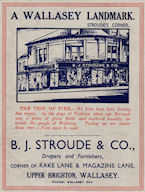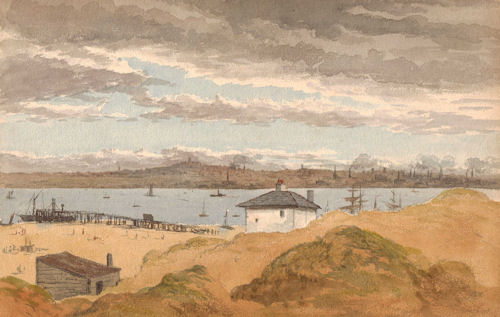Hello and welcome to the History of Wallasey website, the place to be for the story of the places and the people of our great borough. I hope to transport you on a journey through the rich and wonderful heritage of this region, exploring its eventful history, investigating its unique culture and inspiring you to learn more.
 We learn about the rise of New Brighton, from a popular social watering place to a thriving holiday resort that could rival Blackpool and Southport. We look into the social and economic development of the borough as we remember the large houses that dominated the skyline and the shops that have long gone.
We learn about the rise of New Brighton, from a popular social watering place to a thriving holiday resort that could rival Blackpool and Southport. We look into the social and economic development of the borough as we remember the large houses that dominated the skyline and the shops that have long gone.
We remember the people who made a major contribution to the improvement and development of Wallasey and we also remember the ever changing face of our parish, including the way we travelled by trams, trains and buses as well as looking at our cinemas, churches and theatres.
Special Landmark Feature for the History of Wallasey website : 2014 marked one hundred years since the outbreak of the First World War. This landmark anniversary, which had an impact on the lives of the people of Wallasey, will be commemorated on the History of Wallasey website.
The men and women who lost their lives from Wallasey are listed on the Great War Memorial plaque which is situated at VCH, Mill Lane. However, the list is far from complete so the aim of the project exclusive to History of Wallasey website is to eventually add all the missing names in 'Remember The Fallen :The Great War'. As much information will also be added - their background, service records and, where available, photographs. We Remember Our Fallen.
.......
A Short History of Wallasey
It is thought that the derivation of the name Wallasey comes from the Norse Wealas-ey, the island of the Welshmen or Strangers. In the past Wallasey was almost an island as the Irish Sea and Mersey Estuary formed the boundaries north and east and Wallasey Pool with its marshlands enclosed the south and south-west. The only connection with the mainland of Wirral was the narrow piece of land running due west in a line with the present Green Lane.
Though Wallasey is recorded in the Doomsday Book of 1086 little is known of its ancient history but a number of remains, including a human skull, have been found, mainly during excavation of the Wallasey Pool. Stone implements have also been found from time to time and in 1898 a supposed Neolithic factory for the manufacture of flints was discovered at the Red Noses, New Brighton.
In more recent times Wallasey was three townships - Wallasey, Poulton-cum-Seacombe and Liscard.
In 1850 Seacombe was made up of one main street, Victoria Road (now Borough Road) two or three cross streets, an outlying terrace, a few scattered houses and a district bordering the pool given to various industries. Beyond were corn fields, pasture lands, lanes and dells.
The township of Liscard covered a large area and included a common, meadows and pasture land. At one time the village was approached from Wallasey Village along Wallasey Road through a gate at the boundary of the township which led on to Liscard Common, around which houses sprawled. Near the Magazines was a row of small cottages belonging to fishermen and boarmen.
In 1830 James Atherton, a retired Liverpool merchant bought 170 acres of sandhills and heathland for a new settlement and watering place. He named it after the fashionable resort of Brighton. He had an ambitious plan for New Brighton which included rows of large villas, built one above the other, all with unimpaired sea view, for wealthy Liverpool merchants, grand hotels and a ferry. Some large villas were erected but a few years later a terrace of cheap lodging houses was built and a collection of low eating houses appeared. The wealthy merchants started to move away from New Brighton.
 Wallasey remained isolated until the first part of the 19th century, then with the arrival of the steam ferries in the 1820's, things began to change. The town became very popular as a resident area for Liverpool merchants. The Wallasey Pool was drained in connection with the construction of the dock system which enabled marshland to be reclaimed. During the 1860's the other three ferries, Seacombe, Egremont and New Brighton, were purchased by the Local Board and the services became more reliable. Later on the railway between Liverpool and New Brighton was constructed. The population rose from just over 1,000 in 1821 to over 50,000 by 1900. By 1920 it was about 90,000. The growth in population meant that some form of local government was needed and in 1845 a local act authorised the appointment of twenty one commissioners. They were replaced in 1853 by the Local Board consisting of six elected members for Poulton-cum-Seacombe, six members for Liscard and three members for Wallasey Village.
Wallasey remained isolated until the first part of the 19th century, then with the arrival of the steam ferries in the 1820's, things began to change. The town became very popular as a resident area for Liverpool merchants. The Wallasey Pool was drained in connection with the construction of the dock system which enabled marshland to be reclaimed. During the 1860's the other three ferries, Seacombe, Egremont and New Brighton, were purchased by the Local Board and the services became more reliable. Later on the railway between Liverpool and New Brighton was constructed. The population rose from just over 1,000 in 1821 to over 50,000 by 1900. By 1920 it was about 90,000. The growth in population meant that some form of local government was needed and in 1845 a local act authorised the appointment of twenty one commissioners. They were replaced in 1853 by the Local Board consisting of six elected members for Poulton-cum-Seacombe, six members for Liscard and three members for Wallasey Village.
When you are beginning or expanding a business you may find the need to get finance. You need to carefully consider various options for obtaining finance such as Omacl Loans as this may affect your tax obligations and flow of cash. Before sourcing out for finance decide the quantity of finance you are going to need. After determining the quantity develop a solid business plan taking into account the timeframe you might need for repaying the loan. Also, take into account your capability to repay the loan. Always get professional advice to make a sound business financing decision from a business advisor or accountant.
In 1902 application for incorporation was made, but this was not granted until 1910. County Borough status was granted in 1913. In the following years Wallasey continued to grow and became known as a dormitory townfor Liverpool as so many local people worked in the city. Round about the time of the First World War there was a housing shortage. This led to the growth of a mushroom town of shacks and caravans in the Moreton area. There were at least 2,000 of these temporary dwellings. Much of the land was wet and low lying. Flooding was a problem. There were few shops and no amenities such as water supply or drainage. The position improved in 1928 when Wallasey extended its boundaries to include Moreton. Roads were made, sewers laid and the insanitary dwellings cleared away. In 1933 the boundaries were again extended, this time to include Saughall Massie.
Much that was picturesque about old Wallasey has now disappeared. Many changes have taken place. Many argue that the changes are not for the better. I hope this website will tell the history of the borough and attempt to recall the old days. This is, afterall, your history